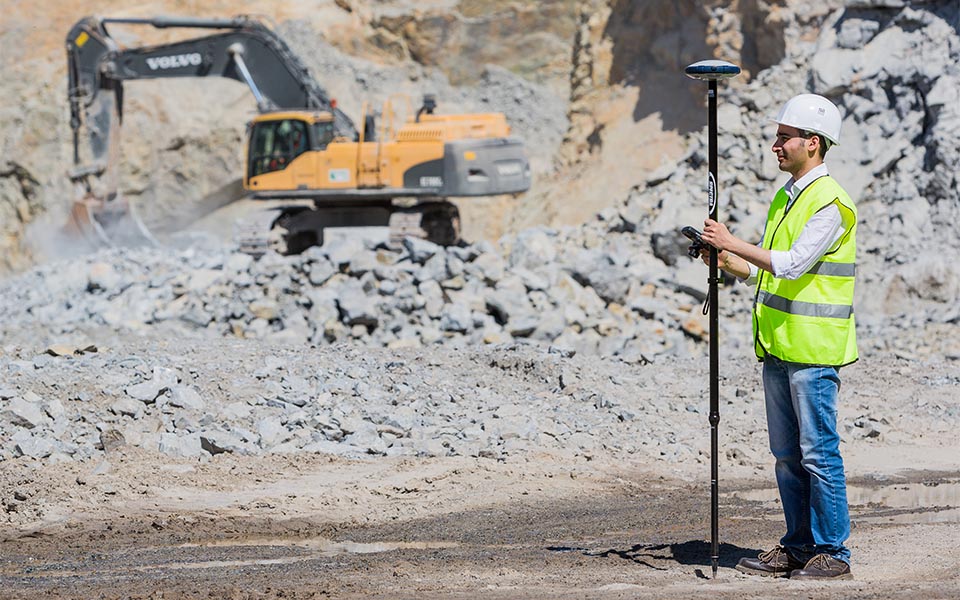How GPS Receivers Improve Site Productivity
- Stockpile volumes – for gauging production and predicting resource needs
- Site Levels – For determining how much Cut or Fill is required to achieve the desired grade
- Boundary Location – To determine the correct boundaries for properties and subdivisions
- Machine Control – Receivers are used on Excavators, Graders, Dozers and more across the site to determine the desired grade to be achieved
Generally, a rover works in combination with a satellite base station located somewhere on or near the jobsite. That stationary base station improves the accuracy of a rover’s position data by receiving correction data constantly providing the GNSS Receiver something accurate to reference its location from. If you are on a site without a GNSS Base correction data can still be achieved through the use of a RTK Correction signal which can be sourced from a RTK Network located around the country.
This RTK Correction signal is gathered through the use of the 4G / 5G network and provides accurate positional data using the corrections of strategically located base stations around the country at which point you access the closes base station to your site to ensure the most accurate data possible.
GNSS Receivers have a variety of different levels of accuracy depending on the models in use. What determines the accuracy of a GNSS Receiver is the ability it has to connect to more satellites than other GNSS Receivers. The more satellites you are able to connect to the more accurate your data will be in a general sense.
There are other contributing factors to the degrees of accuracy that you may achieve with your GNSS Receivers, such as the quality of processors, the boards and chipsets within the units and the antenna strength on your receivers, so when looking to purchase a new GNSS Receiver ensure you ask about these things especially the ability to connect to multiple constellations and not just the standard common GPS and GLONASS.
On more and more sites across the country RTK Corrections are being used and this is ultimately more prevalent within the Agricultural Industry. With good signal to your location you can save alot of money with just needing to connection to a RTK Corrections Service rather than purchasing an expensive GNSS Base and the setup and disconnection of this base daily.
When it comes down to talking about the degree of accuracy you can expect to achieve through the use of a GPS Receiver with or without a base station the accuracy you can expect to achieve is about the size of a golf ball. This relates not only to latitude and longitude position, but also elevation.
Civil construction tends to focus on creating elevations that ensure controlled water drainage. If this is completed within a golf ball size accuracy this is in most instances accurate enough to start preparing runoffs and road surfaces for final construction.
The ability to measure a site to golf ball-size accuracy in a very short window of time can also be used to monitor project progress with unprecedented accuracy. By using GPS Receivers to measure work in progress this gives project managers a better understanding of material use and, as importantly, material, labour and equipment needs for the whole site.
More satellites, more reliability
When it comes to purchasing a GNSS Receiver these days being able to gain access to all the satellites up in the sky is crucial. Most of the big brands on the market will ensure their GNSS Receivers are locked off to certain constellations but try to tell you that this doesn’t matter for what you are trying to achieve. This fact is simply untrue, being able to access more satellites no matter where you are is always better than not being able to. When you are working on a site sometimes obstacles appear such as Buildings, Trees, Bad Weather and Interference on site. Having the ability to connect to more satellites will ensure you are always able to keep working and working to a greater level of accuracy than if you were handicapped to just 2 constellations.
These constellations are as follows; GPS, GLONASS, Galileo, BeiDou and QZSS. The most commonly used constellations within Australia are GPS GLONASS and BeiDou, with BeiDou having the most actively occurring satellites within our region. When a GNSS Receiver is unable to access the most satellites in the sky this handicaps the performance of the GPS Receiver and can cause you unpredictable results, increase downtime of production and the inability to get reliable data.
In short, the more satellites you can see the more accurate your data will be.
How rovers are used in construction
A common rover application is to measure the current levels across a construction site. Instead of walking around with a tape measure, laser level and can of spray paint, a single grade checker with a rover can walk a site, capturing elevation measurements at any point. Using this method of level checking it is vastly quicker than the aforementioned methods and increases the accuracy of the levels obtained.
When on a job site efficiency is everything and maintaining low levels of downtime for your machinery and operators is vital. Being able to quickly obtain levels across your site enables you to provide feedback to your machine operators in a quicker timeframe to ensure you are meeting strict time schedules and even finishing your jobs faster than planned.
Even without extensive survey training it is easy to check levels easily, a Survey tablet and software with the loaded job files allows you to make checking levels as simple as possible and does not require years or training at university to be able to complete the once thought to be difficult tasks.
Another useful application for GNSS Rovers is measuring stockpiles volumes. A person can simply take a rover and walk around the perimeter of the stockpile to capture its size. Then the person can walk up the slope to take shots of both sides to determine its height. Software accompanying the rover can then calculate the volume of material in that stockpile.
Getting rover data to decision makers
Through the use of Data collectors and Survey Software you are now able more effectively than ever before able to transfer data from your site to decision makers, Surveyors and Engineers easily, seamlessly and quickly. having the right survey software on your data collector allows you to make use of the technology in your hands and with minimal training pick up your GNSS Receiver and Data collector and start taking points and increasing the productivity of your site.
The key reason this is useful is because the data is live data which provides your working team with the live condition of he job site so if adjustments or changes need to be made this is done easily and with minimal downtime.

